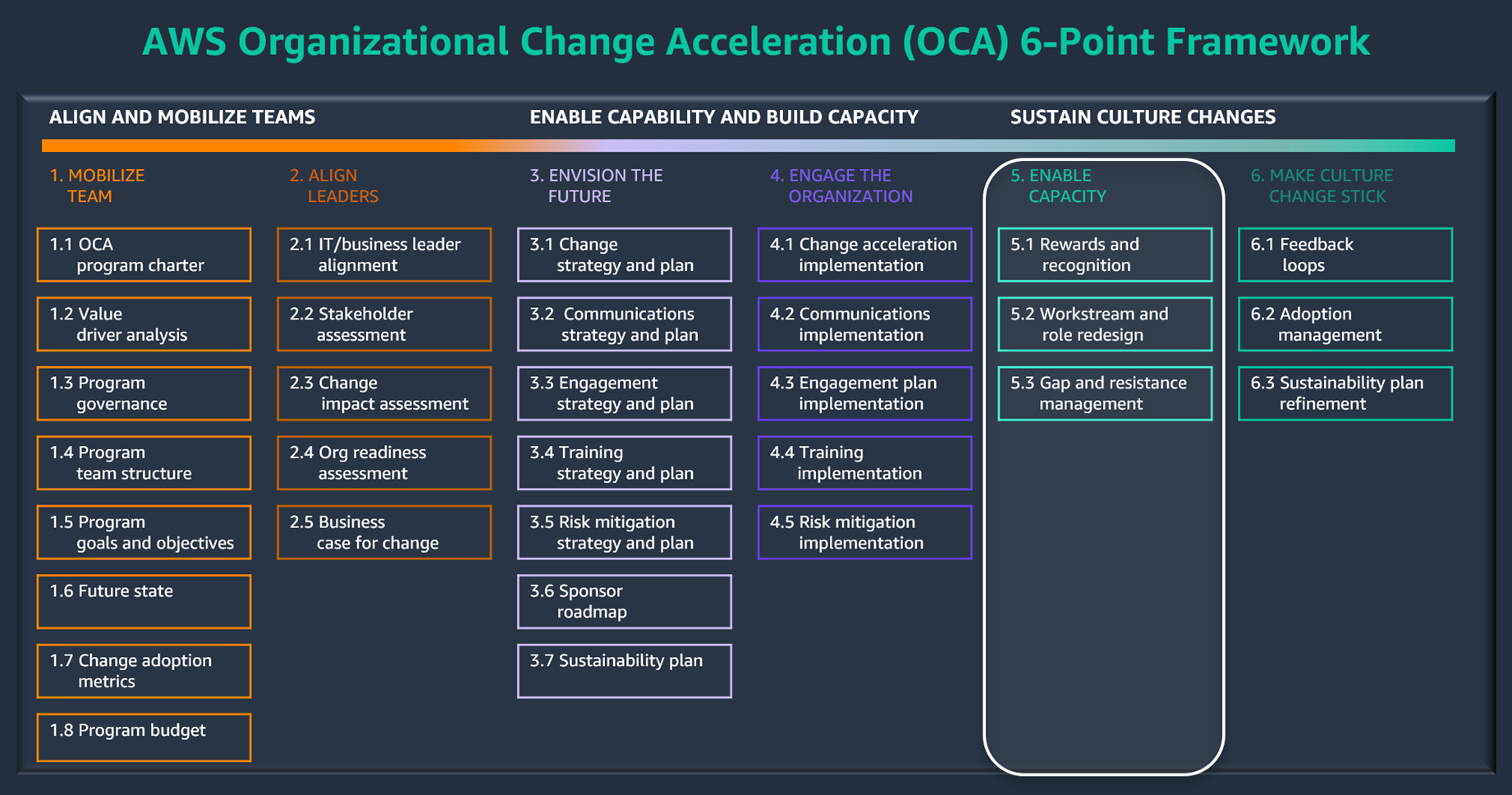Point 5. Enable Capacity
Enable Capacity creates organizational pull for changes by rewarding and recognizing key behaviors, redesigning roles to match the needs and ongoing requirements for new capabilities, and managing stakeholder resistance that might emerge in the process. Enable Capacity contains three subpoints:
5.1 Provide rewards and recognition
5.2 Redesign workstreams and roles
5.3 Discuss gaps and manage resistance
This section provides a brief overview of Enable Capacity and its subpoints. For a detailed discussion, see the guide AWS Organizational Change Acceleration (OCA) 6-Point Framework – 5. Enable Capacity.

5.1 Provide rewards and recognition
What is it?
Rewards and recognition provide a mechanism for highlighting key behaviors and reinforcing them in support of the cloud transformation. Over time, the new behaviors will drive a new culture throughout the organization. A reward is something that is given in return for good behavior or for some service or achievement. A reward can also be a stimulus that follows a correct or desired response and encourages the reoccurrence of the response. Recognition is an acknowledgment, special notice, or attention that highlights an achievement. A good reward and recognition system pulls people in because they see what is being rewarded and recognized, they feel good about receiving (and maybe giving) rewards and recognition, and they want to be part of it. However, research indicates that behaviors take about 20 tries before they are assimilated into a person’s normal patterns. In other words, organizations require both patience and consistency to fully integrate people into a rewards and recognition culture.
Why is it valuable?
Rewards and recognition provide an appreciation of good work and new behaviors. Employees in a traditional organization might oppose certain behaviors that are necessary for a cloud transformation. In the context of a cloud transformation, leaders should reward and recognize behaviors that might not match the previous ways of working. For example, experimentation, failing fast, working back from the customer, and decentralized decision making might be new behaviors for an organization. As a result, recognizing and rewarding these behaviors will be effective in signaling that things need to change. In addition, the organization must be able to get a return on reward (ROR) in order to sustain any initiative. For example, if you offer a gift card to employees who get a cloud solutions architect certification, their improved skill set will deliver more value to the organization than the money you invested in the gift card.
When do you use it?
Rewards and recognition should be given to participants in a variety of roles and levels, through a mixture of informal and formal channels, with abundance, and in a timely manner. Timeliness is key to ensuring that the reward or recognition recipients and other observers make the connection between the behavior and the positive consequences of it. For formal rewards and recognition, follow an established cadence that people can anticipate. Informal rewards and recognition should be ad hoc and involve an element of surprise.
5.2 Redesign workstreams and roles
What is it?
Role redesign helps shape the changing roles of future work. It is the process of reshaping tasks and responsibilities to better align with both internal and external changes in an organization. For example, digitization and automation might impact roles inside the organization.
Why is it valuable?
In cloud migration and modernization, the objective of workstream and role redesign is to assess and design the roles needed to support a designated workstream in a future state operating model. The activities focus on identifying and preparing the organization for the transition to redesigned processes and the new system―and potentially change employee and end-user roles, job tasks, workflows, competencies and metrics.
When do you use it?
Determining when to begin role redesign depends on the timelines and objectives of the
organization and cloud transformation. It is helpful to review roles a few times every year
and create new training plans, succession plans, hiring plans, and development plans as a
result. This activity should be conducted with the members of IT, business, and HR teams.
AWS offers specific role ramp-up
guides
5.3 Discuss gaps and manage resistance
What is it?
Resistance to change is a normal human reaction, but managing that resistance can present an organizational challenge. Change acceleration actively seeks to understand the level of readiness and minimize the resistance of people who are affected by cloud transformation. Factors that increase resistance to a change include ambiguity in vision, inadequate understanding of benefits and business value, limited leadership support and involvement, and inadequate communication at every level of the organization. These factors can lead to misinformation, uncertainty, skepticism, indifference, and ultimately inaction.
Why is it valuable?
As you identify areas of resistance, dive deep to determine root causes and pockets of resistance, develop corrective action plans, and enable sponsors and leaders to manage resistance. These actions can help remove friction and prevent the cloud transformation from stalling or derailing.
When do you use it?
If the executive sponsors of a cloud transformation program have been building alignment with their peers, communicating value, and driving momentum on a continuous basis, resistance will be rare. When you do encounter resistance, strategize and thoughtfully plan your response in a way that appeals to the political, logical, and emotional perspectives. Getting top-down support can be necessary to diffuse strong resistors or to rationalize the cloud transformation with a new strategic initiative.
To manage resistance effectively:
-
Listen and understand objections.
-
Focus on the what instead of the how.
-
Remove barriers to transformation.
-
Provide simple, clear choices and consequences.
-
Create hope.
-
Show the benefits in a real and tangible way.
-
Make a personal appeal.
-
Convert the strongest dissenters, and have them spread the word.